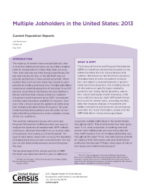Multiple Jobholders in the United States: 2013
Multiple Jobholders in the United States: 2013
Introduction
The majority of workers have one paid job at a time. A small but stable percentage use secondary employment to compensate for things their main job lacks. Their main job may not offer enough work hours, the pay rate may be too low, or the job itself may not provide satisfaction or have growth potential. When workers face such barriers, they may choose to compensate by holding additional jobs. Multiple jobholders comprise an established portion of the labor force (4.9 percent, according to the Bureau of Labor Statistics [BLS]) and have had a steady presence—between 4.5 percent and 6.2 percent since 1970. Annual and monthly rates have been available for decades, however, little is known about the patterns of jobholding that multiple jobholders follow throughout the year. Understanding these patterns and the extent of multiple jobholding will provide a more complete picture of the U.S. workforce.
The recently redesigned Survey of Income and Program Participation (SIPP) provides new ways to analyze the dynamics of employment. SIPP collects continuous, detailed information on up to seven jobs or businesses held during a 12-month period. This type of data allows researchers to study the dynamics of employment and provides comprehensive information on jobs held and businesses owned throughout the year.
Taking advantage of the unique qualities of SIPP, this brief uses data from the first year of collection to explore multiple jobholding in the United States throughout 2013. This brief answers four main questions. First, what proportion of working men and women held multiple jobs and how many jobs did they hold? Second, how did multiple jobholding vary throughout the year? Third, how did multiple jobholders balance their time across jobs and what factors motivated this decision? Finally, what types of jobs or businesses were held simultaneously?




